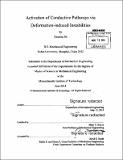| dc.contributor.advisor | Mary C. Boyce | en_US |
| dc.contributor.author | Ni, Xinchen | en_US |
| dc.contributor.other | Massachusetts Institute of Technology. Department of Mechanical Engineering. | en_US |
| dc.date.accessioned | 2014-12-08T18:54:08Z | |
| dc.date.available | 2014-12-08T18:54:08Z | |
| dc.date.issued | 2014 | en_US |
| dc.identifier.uri | http://hdl.handle.net/1721.1/92170 | |
| dc.description | Thesis: S.M., Massachusetts Institute of Technology, Department of Mechanical Engineering, 2014. | en_US |
| dc.description | "June 2014." Cataloged from PDF version of thesis. | en_US |
| dc.description | Includes bibliographical references. | en_US |
| dc.description.abstract | Inspired by the pattern transformation of periodic elastomeric cellular structures, the purpose of this work is to exploit this unique ability to activate conductive via deformation-induced instabilities. Two microstructural features, the contact nub and the conductive pathway, are introduced to make connections within the void and between the voids upon pattern transformation. Finite element-based micromechanical models are employed to investigate the effects of the contact nub geometries, conductive pathway patterns and elastic properties of the coating and substrate materials on the buckling responses of the structure. Finally, a flexible circuit that can be switched on and off by an applied uniaxial load is fabricated based on the finite element analysis and demonstrated the ability to activate conductive pathways in response to an external triggering stimulus. | en_US |
| dc.description.statementofresponsibility | by Xinchen Ni. | en_US |
| dc.format.extent | vi, 65 pages | en_US |
| dc.language.iso | eng | en_US |
| dc.publisher | Massachusetts Institute of Technology | en_US |
| dc.rights | M.I.T. theses are protected by copyright. They may be viewed from this source for any purpose, but reproduction or distribution in any format is prohibited without written permission. See provided URL for inquiries about permission. | en_US |
| dc.rights.uri | http://dspace.mit.edu/handle/1721.1/7582 | en_US |
| dc.subject | Mechanical Engineering. | en_US |
| dc.title | Activation of conductive pathways via deformation-induced instabilities | en_US |
| dc.type | Thesis | en_US |
| dc.description.degree | S.M. | en_US |
| dc.contributor.department | Massachusetts Institute of Technology. Department of Mechanical Engineering | |
| dc.identifier.oclc | 897136926 | en_US |
